
Zealand at 7,031 km2 is the largest and most populous island in Denmark proper. Zealand had a population of 2,319,705 on 1 January 2020.

DSB, an abbreviation of Danske Statsbaner, is the largest Danish train operating company, and the largest in Scandinavia. While DSB is responsible for passenger train operation on most of the Danish railways, goods transport and railway maintenance are outside its scope. DSB runs a commuter rail system, called the S-train, in the area around the Danish capital, Copenhagen, that connects the different areas and suburbs in the greater metropolitan area. Between 2010 and 2017, DSB operated trains in Sweden.

The rail transport system in Denmark consists of 2,633 km of railway lines, of which the Copenhagen S-train network, the main line Helsingør-Copenhagen-Padborg, and the Lunderskov-Esbjerg line are electrified. Most traffic is passenger trains, although there is considerable transit goods traffic between Sweden and Germany.
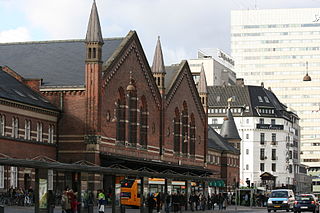
Copenhagen Central Station is the main railway station in Copenhagen, Denmark, and the largest railway station in Denmark. With more than 100,000 travellers every day, it is the second busiest station in Denmark after Nørreport station. It is located in central Copenhagen, situated between the districts of Indre By and Vesterbro with entrances from Bernstorffsgade, Banegårdspladsen, Reventlowsgade and access to platforms from Tietgensgade.

Aarhus Central Station is the main railway station serving the city of Aarhus, Denmark. Serving as the main connecting hub for rail traffic between Aarhus and the rest of Denmark, the station is used by an average of 6.3 million people per year, making it the busiest station in Denmark outside the Copenhagen area. It is located in the city centre between the districts of Midtbyen and Frederiksbjerg with entrances from Banegårdspladsen and the shopping centre Bruun's Galleri, and with access to platforms from M.P. Bruuns Gade.
The Copenhagen–Fredericia/Taulov Line is the Danish railway line between the capital, Copenhagen, and the Jutland peninsula by way of Funen. It is administered by Banedanmark and has a length of about 220 kilometres (140 mi). Being one of the main arteries of the Danish railway network, it has double track and is fully electrified.

The Marsh Railway is a main line in the state of Schleswig-Holstein in Germany that links the stations of Elmshorn in the south and Westerland on the island of Sylt in the north. It is part of 237 km (147 mi) long route from Hamburg-Altona to Westerland (Sylt) and is listed in the Deutsche Bahn timetables as Kursbuchstrecke 130. The first part of it was opened in 1845 and is one of the oldest lines in Germany.

The Great Belt ferries were the train and car ferries operating across the Danish strait of Great Belt, between the islands of Zealand and Funen. The railway ferry link was established in 1883, while automobile-only ferries started operating in 1930. The ferry services ceased operating with the opening of the Great Belt Fixed Link, which occurred in 1997 for rail and 1998 for car traffic.

Padborg station is a railway station in the Danish town of Padborg in the southern part of Jutland. The station is located on the Fredericia–Flensburg railway line and is the last Danish train station before the border with Germany which lies immediately south of the station. To the west, Tønder in Denmark on the route to Niebull is a further border station.
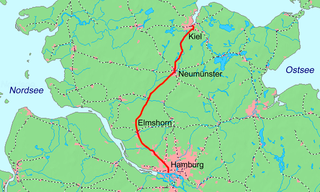
The Hamburg-Altona–Kiel railway is the oldest railway line in the German state of Schleswig-Holstein, and the first railway in Denmark or its dependencies at the time, and first to reach the Baltic Sea. Today, it connects Hamburg, Neumünster and Kiel. It is one of the first railways in Germany. When it opened in 1844, Altona and Kiel were the largest cities in the Duchy of Holstein. The line is now owned by DB Netz.

The Neumünster Flensburg Railway is part of the Jutland line, the main north–south rail link through Schleswig-Holstein, Germany. Together with the line to Husum, which diverges in Jübek, and the line to Kiel, which diverges in Rendsburg, it also serves as an important east–west axis between Kiel and the Marsh Railway on the west coast. It consists of several sections that were parts of the first railways in the current territory of Germany.
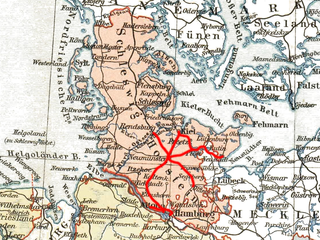
The Altona-Kiel Railway Company was a joint-stock company, established under the law of Denmark in personal union with the Duchy of Holstein, that built and operated an 105 km railway line between Altona and the Baltic Sea port city of Kiel. Altona was at that time the second largest city under Danish rule and the railway line was the first built in Danish-controlled territory.

Roskilde Station is the principal railway station serving the city of Roskilde, Denmark, situated on the Danish Main Line between Copenhagen and Jutland. The station is also a terminus for the Lille Syd Line which connects Roskilde to Næstved by way of Køge, and the Nordvest Line to Kalundborg.
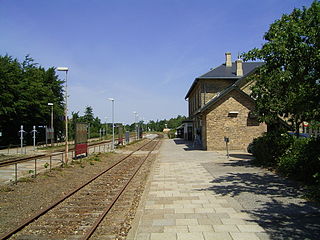
The Randers–Aalborg line or the Randers–Aalborg railway is a 80.7 km (50.1 mi) long standard gauge double track railway line in Jutland, Denmark which runs through the historical region of Himmerland between Randers and Aalborg. It constitutes a section of Den Østjyske Længdebane, the through railway line through the Jutland Peninsula from Padborg to Frederikshavn.

The Langå–Struer railway line is a 102.4 km (63.6 mi) long standard-gauge single-track railway line in Denmark which runs through the central Jutland region between Langå and Struer.

The Aarhus–Randers line or the Aarhus–Randers railway is a 59.2 km (36.8 mi) long standard gauge, double track railway line in Denmark which runs between the cities of Aarhus and Randers in East Jutland. It constitutes a section of Den Østjyske Længdebane, the railway line through the Jutland Peninsula from Padborg to Frederikshavn.
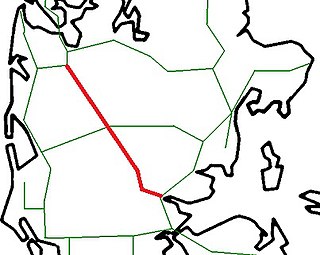
The Vejle–Holstebro railway line is a 114.0 km (70.8 mi) long standard-gauge single-track railway line in Denmark which runs through the central Jutland region between Vejle and Holstebro.
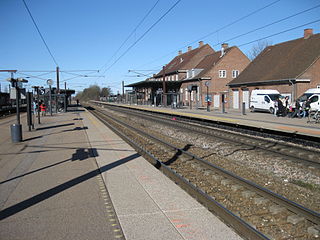
Ringsted railway station is a railway station serving the town of Ringsted in central Zealand, Denmark. It is located in the centre of the town, on the southern edge of the historic town centre, and immediately adjacent to the Ringsted bus station.
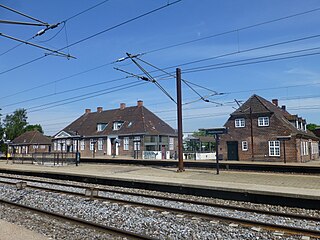
Hedehusene railway station is a railway station serving the railway town of Hedehusene, a suburban town of Copenhagen in Zealand, Denmark. It is located in the centre of the town, immediately adjacent to Hedehusene's bus station.




















